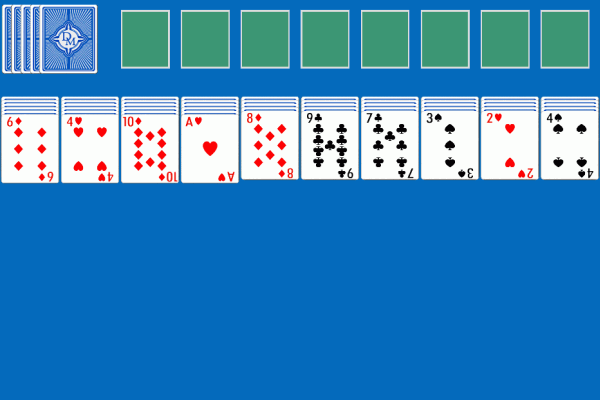 Dogmelon Solitaire
Dogmelon Solitaire
Spider Solitaire
Spider Solitaire is a hugely popular two-deck game. It has a low success rate, requiring a good deal of luck, but also a lot of skill. It can take over half an hour to play spider solitaire, so don't start a game when you just have a brief moment! There are variations to make the game easier, which can make the game more enjoyable for some.
Aim:
The aim of Spider Solitaire is to build ascending suit sequences in the foundation zone.
How to Play:
Cards can be moved in the manoeuvre zone, onto cards of 1 higher rank, regardless of suit
Multiple cards can be moved as a run, but only if they form a descending sequence of the same suit
Any Card (or run), can be moved into a vacant manoeuvre stack.
Clicking the talon will deal one new card to each manoeuvre stack. Dealing these cards introduces new cards into play, but also covers other cards. A good general strategy for spider solitaire is to move as many cards as possible before dealing from the talon.
Spider solitaire ends when all cards are moved into the 8 foundation stacks.
The 1-suit and 2-suit variations of spider solitaire are easier than the 4-suit version. Because there are less suits, it is easier to form same-suit runs. These raise the success rate significantly. In particular, 1-suit spider solitaire is quite easy, and can be a good place for beginners to start.
Spider Solitaire Strategy:
The key to winning spider solitaire is being very careful with your moves.
Same-suit sequences are more useful than mixed-suit sequences, because they can be moved all at once as a single block. Therefore when you have a choice, prefer same-suit sequences.
Empty columns are very useful, allowing more manoeuvres. Try using them as "free cells", using them temporarily, but leaving them empty. The more enpty columns you have, the higher your chances of being able to finish the game.
Example:
Suppose that the initial spider solitaire deal looks like this:

The starting layout for Spider Solitaire, deal #1
Here are some initial moves:
- Ace of Hearts to 2 of Hearts (exposes 3 of Hearts)
- 2 of Hearts to 3 of Hearts
- 8 of Diamonds to 9 of Clubs
- 7 of Clubs to 8 of Diamonds
- 6 of Diamonds to 7 of Clubs
The game now looks like this:

The next move in this spider game would probably be the 3-2-Ace of Hearts onto a 4 of Hearts
Mixed V Same Suit Sequences...
Now we can illustrate the difference between same-suit sequences and mixed-suit sequences. This is very important to understand- as it's one of the keys to playing spider solitaire...
See the Heart sequence, 3,2,Ace, in the 4th column?
Because that sequence is all one suit, it can be moved as one unit, onto any of the fours. We would probably move it to one of the 4 of Hearts (say the second column), to keep the same suit sequence going.
See the 9C-8D-7C-6D sequence, in the 6th column?
In spider solitaire, that sequence can not be moved in one go to the 10 of Diamonds, because it is a mixed suit sequence.
Clearly, same-suit sequences are preferable to mixed when playing Spider Solitaire.
